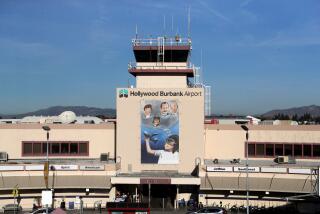Plants Survive on His Untended Farm : Neglect Threatens Luther Burbank’s Legacy
SEBASTOPOL, Calif. — It is a nondescript triangle of matted grass, bounded by a busy highway, a cemetery and a housing project, each in its way a totem of modern California.
A mighty hybrid royal walnut flourishes on this tract, but scraggly grape vines clutch a falling trellis, a decrepit plumcot heroically sends out a few lavender blossoms and thornless blackberry canes sprawl in a tangle along the edge of the property line.
The horticultural relics scattered about these three forlorn and untended acres are all that remain of one of the most important farms in American history: Goldridge, where Luther Burbank conducted his experiments.
In its day, Goldridge was a magnet for the famous and the curious. They flocked here from all over the world to see the plant wizard, as Burbank has been known to generations of schoolchildren, and the place where he created hundreds of plant varieties, some of which remain important today.
Before he came here in 1875, the young Burbank already had made a mark. He discovered perhaps the most vital of his contributions, the Burbank russet potato, at home in Massachusetts and used the profits from its sale to move to Santa Rosa. Heirs of the Burbank russet are the potatoes of choice for some of today’s top fast-food chains.
Bought Land for Nursery
Within 10 years, Burbank had made enough money as a nurseryman to buy the tract that became Goldridge, easily the best-known 18 acres of farmland in the world at the turn of the century. The place became such an attraction that Burbank had to secrete himself behind locked gates and fences to be able to work in solitude with the millions of plants that he propagated.
It was here that Burbank developed his Santa Rosa and Satsuma plums, as well as more than 50 other varieties of that fruit. From Goldridge came the Shasta daisy and many other flowers, the July Elberta peach, the thornless blackberry, a white strawberry and scores of other nuts, fruits, flowers and vegetables.
Before his death in 1926, Burbank sold about three acres of Goldridge for use by the cemetery. Many of the remaining plants were catalogued and sold under contract to a Missouri nursery. Then, in 1972, his widow sold 12 more acres for an elderly housing project known as Burbank Heights.
The last living signs of the plant wizard’s experimentation grow wild on the three acres that remain of Goldridge and, incredible as it might seem, local horticultural historian Robert Hornback has counted more than 200 Burbank specimens that continue to thrive here.
Since 1975, Hornback and Renee Felciano, a Santa Rosa landscape architect, have been leading a Western Sonoma County Historical Society campaign to save the last of Goldridge from further depredation and create a preserve with as many Burbank plant creations as possible for study by horticulturists.
One problem is that the public housing body that governs Burbank Heights must have approval of the U.S. Department of Housing and Urban Development before it cedes the tract to the City of Sebastopol and the preservationists.
“The board is sympathetic,” Felciano said, “but HUD guaranteed the mortgage, and the board has been reluctant to move on this until it gets approval of an expansion of the housing project. . . . We have walked on cracked eggs for a long time.”
Housing board member Paul Schoch said the board has not dealt with the land transfer because of a fear of confusing HUD and creating other problems for the housing project expansion. “I don’t think there’s a problem,” he said. “In general, the board consensus is that, yes, it would be in agreement to the transfer.”
The society’s other problem is money, which it has been trying to raise to keep weeds and brambles from snuffing out the rest of Burbank’s legacy and to finance refurbishing and stocking of Goldridge with other Burbank specimens.
“Burbank’s home and garden (well-preserved in Santa Rosa, seven miles northeast of here) were the showplace, but Goldridge was the outdoor laboratory,” Hornback said. “I’d like to see further damage halted. It needs to be fenced and then made into a repository of Burbank plants--a living library.
“The man was a saint, a phenomenon, self-taught. . . . You can get the feeling when you go out to Goldridge. You can see the old guy at work out there.”
In fact, it takes no great leap of imagination. The trees and plants show the hardiness that Burbank sought; the grassy turf is pocked with the same gopher damage that forced Burbank to abandon his work with the gladiolus.
It is almost as though he were watching from afar, extending his caring touch to the last of his plants and waiting for the day that Sonoma County will decide to complete this simple temple to his memory.






